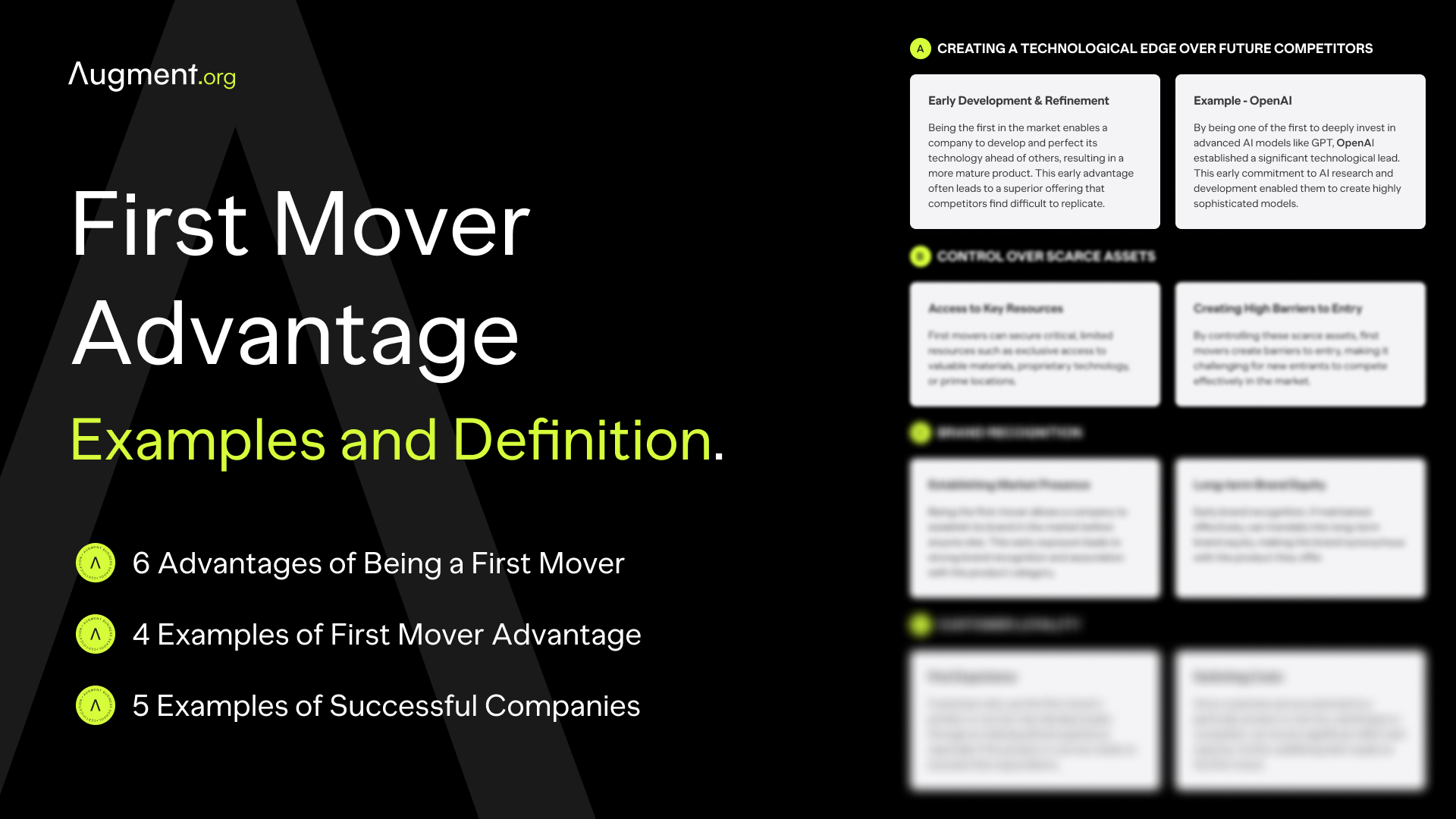First Mover Advantage: Examples and Definition
First mover advantage grants pioneering companies a competitive edge, allowing them to establish strong brand recognition and customer loyalty early on. This concept is crucial for businesses striving to gain market share and create a lasting impact in their industry.

What is a First Mover?
A first mover company gains a competitive advantage by being the first to market with a product or service. This pioneering position allows the company to establish itself as an industry leader, often benefiting from strong brand recognition and customer loyalty. Companies with first mover status can shape industry standards and set the bar for future competitors, creating a significant brand presence in the business world.
6 Advantages of Being a First Mover
Being a first mover in the market can offer several advantages that pave the way for a company's success. First mover advantages include:
- Brand Name Recognition and Loyalty: First movers often establish significant brand recognition and customer loyalty. Being the first company with a new product or service allows them to become synonymous with that market segment.
- Setting Industry Standards: These companies have the unique opportunity to set industry standards, shaping expectations and norms for future competitors.
- Competitive Advantage through Innovation: First movers typically lead in technology and innovation, giving them a competitive edge in the market.
- Higher Profit Margins: By being the first to market, these companies can set the market price and enjoy higher profit margins due to less initial competition.
- Creating Buyer Switching Costs: The introduction of a new product or service by a first mover can create switching costs for customers, making it harder for them to switch to a competitor’s offering later.
- Establishing a Strong Market Presence: Successful first movers can build a solid foundation and a loyal customer base, positioning themselves as industry leaders.
6 Drawbacks of Being a First Mover
Despite the potential benefits, being a first mover also comes with its share of drawbacks. According to research conducted by the Harvard Business Review, the fate of a first mover is significantly influenced by both the speed at which the company's market is growing and the speed at which the product's technology is advancing. For example, if a product's technology rapidly evolves, the first mover's product quickly becomes obsolete.
Here are a few other factors that pose a risk to a first mover advantage's fate:
- Higher Risk and Uncertainty: First movers often face significant risks as they navigate uncharted territories without a pre-established market. This uncertainty can lead to higher initial investment costs, especially in research, development, and marketing.
- The Burden of Educating the Market: First mover companies frequently bear the responsibility of educating consumers about a new product or service, which can be costly and time-consuming.
- Risk of Rapid Technological Change: In fast-evolving industries, first movers might invest heavily in a technology that quickly becomes obsolete, leaving them at a disadvantage compared to later entrants who adopt newer, more efficient technologies.
- Potential for Poor Execution: Being first doesn’t always mean being the best. First movers might suffer from flaws in execution, which can tarnish brand reputation and leave room for competitors to improve upon their offerings.
- Copycat Competitors: Second mover companies can capitalize on the first mover's product by reverse-engineering or improving upon it, often with lower costs since they don’t have to recoup the initial development expenses.
- Resource Drain: Initial market entry can consume significant resources, from talented employees to key suppliers, which might strain the company’s ability to sustain long-term growth.
4 Examples of First Mover Advantage
Here are four real-life examples that illustrate how being the first mover in a respective market helps establish brand loyalty, set industry standards, and achieve lasting success:
- Coca-Cola: Coca-Cola, launched in 1886, was not the first soda brand but became the market leader. Its strong brand recognition and customer loyalty have kept it ahead of competitors like Pepsi, which entered the market later. Despite Pepsi's various strategies, including mergers and rebranding, Coca-Cola's beverage brands have achieved over $1 billion in sales, a feat Pepsi has struggled to match.
- Amazon: Amazon started as the first major online bookseller, outperforming traditional bookstores like Barnes & Noble and Borders. This first mover advantage enabled Amazon to expand into other retail categories, leveraging its early start to establish cost efficiency, premium membership benefits, and fast delivery, which accumulated a large base of loyal customers. Amazon's success in the online retail space is a testament to its strategic use of the first mover advantage.
- Apple: Apple dramatically changed the mobile phone landscape with the launch of the first iPhone in 2007. Although other companies like HTC followed with Android devices, Apple has maintained its status as the original and most preferred smartphone brand. The loyalty rates for Apple's iOS and Google's Android are closely aligned, but Apple's pioneering role has helped it retain a unique market position.
- eBay: Established in 1995, eBay became the world's largest online auction site, surviving the dot-com bubble and fending off competition from Amazon's auction spinoff. Strategic acquisitions, including PayPal and iBazar, have helped eBay maintain its market relevancy and dominance, demonstrating the enduring power of the first mover advantage in the e-commerce space.
5 Examples of Successful Companies That Were Not First Movers
These examples illustrate how companies can still achieve significant success, even if they enter the market later than their competitors:
- Facebook: Preceded by social networks like Friendster, Myspace, Classmates.com, and SixDegrees.com, Facebook entered the scene later but managed to outperform these early pioneers. Facebook's ability to evolve and adapt to user needs turned it into the dominant social networking platform it is today.
- Starbucks: In a market already filled with coffee shops, Starbucks distinguished itself by creating a unique "third place" between work and home. This innovative approach helped Starbucks carve out a significant niche, turning it into the global coffee phenomenon it is today.
- Google: Although not the first search engine, Google surpassed predecessors like Magellan, Infoseek, and Yahoo by offering a more effective and efficient search experience. This innovation allowed Google to become a verb in the English language and take control of a major portion of search activity.
- Zappos: In the shoe retail sector, Zappos emerged with the largest selection of shoes online and a consumer-friendly 365-day return policy. This strategy enabled Zappos to surpass long-established department stores, becoming the largest online shoe retailer.
- Spotify: Despite the presence of other legal music streaming services like Pandora and SoundCloud, Spotify's user-friendly on-demand streaming service successfully converted many users into paying customers. Spotify now dominates a significant share of the on-demand streaming market.
These companies demonstrate that while first mover advantage can be beneficial, it is not the only path to success. Strategic innovation, customer-centric approaches, and effective market adaptation are also key factors in achieving commercial triumph.



